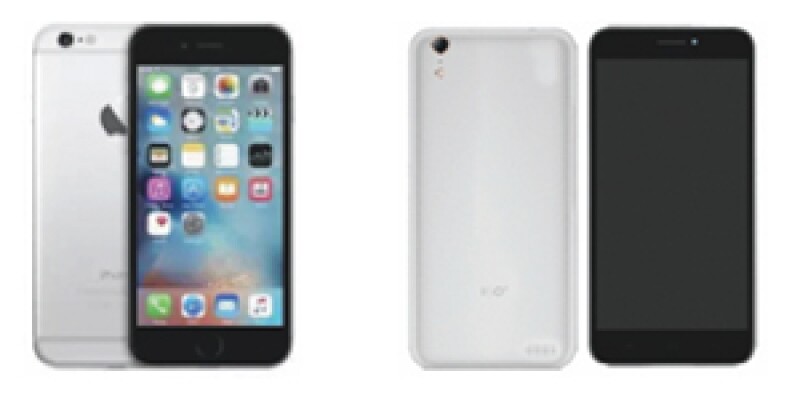In May 2016, the government authority the Beijing Intellectual Property Office (Beijing IPO) published a decision affirming that Apple's iPhone 6 and iPhone 6 Plus infringe a Chinese design patent number ZL201430009113.9, owned by a Shenzhen Baili Marketing Service Co Ltd. The Beijing IP Office's decision orders Apple to stop selling the iPhone. Apple has reportedly brought a lawsuit to seek judicial review of this administrative decision. The case is pending.

|
|
Accused product |
Design patent in dispute |
The Beijing IPO's decision has been under a lot of spotlight since the decision was issued. Many Chinese patent experts seem to find it questionable that the iPhone 6 or 6 Plus have infringed Shenzhen Baili's design patent.
A key patent issue here is the so-called design space, and how the rules related to design space play out in the China invalidation and infringement actions. Article 14 of the recent Interpretation (II) of the Supreme People's Court on Several Issues concerning the Application of Law in the Trial of Patent Infringement Dispute Cases (SPC Judicial Interpretation II) stipulates that, in determining the knowledge and cognitive capability of a normal consumer regarding a design, the people's court shall normally consider the design space of such products with designs identical or similar to the patented design at the time that the accused infringement occurs. Where there is a larger design space, the people's court may conclude it is not easy for a normal consumer to notice a relatively minor difference between different designs; where there is a smaller design space, the people's court may conclude it is easier for a normal consumer to notice a relatively minor difference between different designs.
In this case, if the accused products have a larger design space, a stricter standard in determining identity or similarity between different designs should be applied; otherwise a looser standard should be applied.
The Beijing IPO's decision states that, although the designs of the accused products and the design patent in dispute have various differences, these differences are so minor that a normal consumer is unlikely to notice the differences; and, because a normal consumer is unlikely to notice the differences, it is proper to conclude that the external designs of the iPhone 6 and 6 Plus are not so significantly different from the design patent in dispute and that the accused products would fall within of the protection scope of the design patent. Although the Beijing IPO does not refer to the issue of design space, it appears that the officials of the Beijing IPO consider there is a large designs space for the touch screen mobile phones and therefore minor differences are not noticed by the normal consumers.
However, the Patent Re-examination Board of the SIPO, which handles invalidity proceedings in China, apparently does not think so. In the patent invalidation proceeding launched by Apple against the Shenzhen Baili design patent, the Board found that the design patent in dispute had obvious differences with prior designs, particularly the curved design of the side of the mobile phones, and that such differences significantly impact the overall visual effect of the products. The decision seems to suggest the Board considers the design space of the accused products to be small, and thereby holds that minor differences such as the curve design of the side of the mobile phones are sufficient enough for patentability.
It is somewhat surprising that Beijing IPO seems not to notice the decision of the Board. If the Board upholds the patentability of the patent, the same standards on the design space should be applied to the infringement determination. In other words, as the Board can distinguish the Shenzhen Baili design patent from various other prior art based on small changes, the iPhone 6 or iPhone 6 Plus should be compared with the asserted patent under the same standards – small changes may lead to non-infringement.
We hope that the appellate court – the Beijing IP Court – will make a clear ruling on how to determine the design space relating to the external design of the touch screen mobile phones. We will not be surprised that the same Board decision has been also brought to the Beijing IP Court for judicial review as well. The Beijing IP Court has to make a coherent standard.
In addition to the legal issues of design patent infringement determination, some experts have raised serious concerns over the fact that Beijing IPO, as an administrative authority, issued an injunction against an important mobile phone product. Experts are asking why patent enforcement in China should be dealt with by both courts and local IPOs, and questioning whether this bifurcated approach will cause confusion and inconsistent judgments. This has been a hot topic for the fourth patent law amendments. Beijing IPO's decision in this case will no doubt be examined closely, as an example of success or failure of the administrative enforcement system in China.

|

|
He Jing |
Liu Liangyong |
AnJie Law Firm26/F, Tower D, Central International Trade Center6A Jianguomenwai Avenue, Chaoyang District, Beijing 100022, PR ChinaTel: +86 10 8567 5988Fax: +86 10 8567 5999wuli@anjielaw.comwww.anjielaw.com









